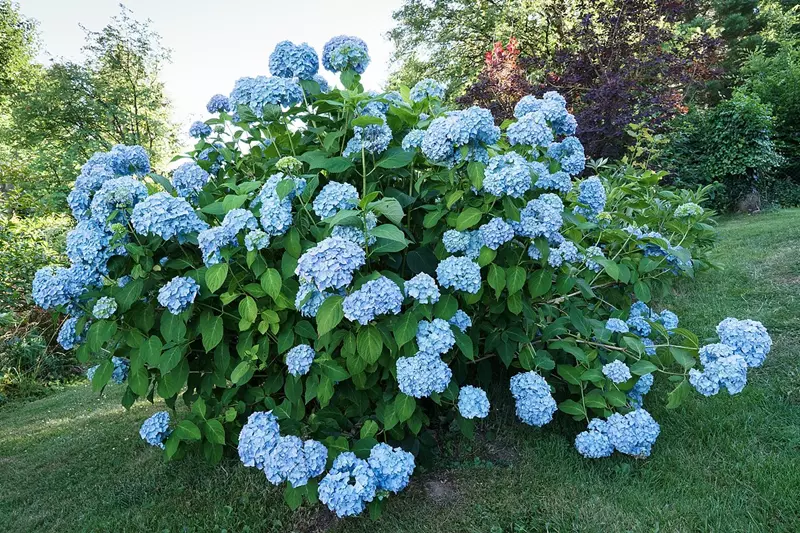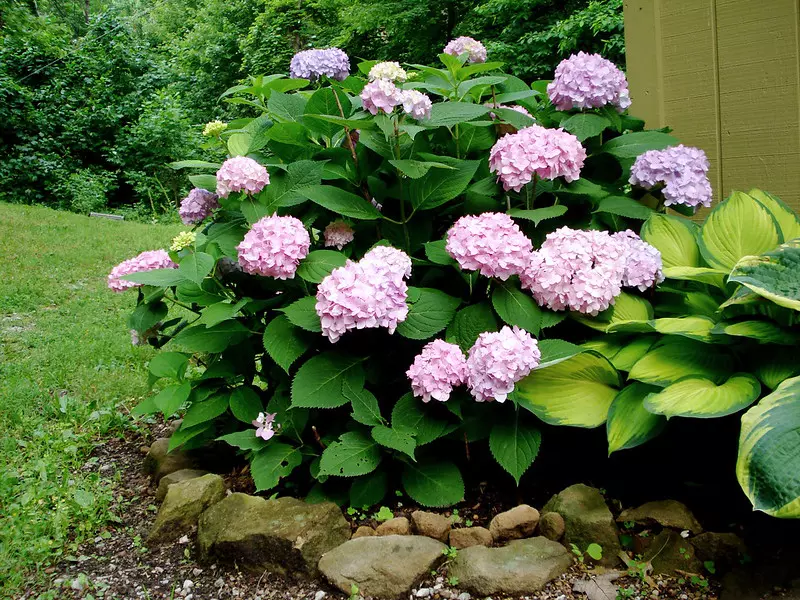
The Ultimate Guide to Hydrangea macrophylla (Garden Hydrangea)
A complete guide to Hydrangea macrophylla, including planting, pruning, soil adjustments, eco-friendly pest management, propagation, and garden design ideas.
Read MoreThe 'Nikko Blue' hydrangea is ideal for gardeners seeking a vibrant, long-blooming shrub that thrives in partial shade. Its adaptability to various soil typessoil and stunning blue flowers make it a versatile addition to many garden styles.

This hydrangea variety excels in:
Hydrangea macrophylla 'Nikko Blue' is a versatile and visually striking shrub suitable for various garden settings. Its extended bloom period and ability to attract pollinators make it a valuable addition to the landscape. However, gardeners should be mindful of its cold sensitivity and the need for soil pH management to maintain optimal flower colour. With proper care, 'Nikko Blue' can be a standout feature in your garden.
Hydrangea macrophylla 'Nikko Blue' is a deciduous shrub renowned for its vibrant blue blooms and lush foliage. Understanding its growth habits is essential for optimal cultivation and landscape integration.
This hydrangea typically reaches a height and spread of 4 to 6 feet (1.2 to 1.8 meters), forming a rounded, bushy shape. Its compact size makes it suitable for various garden settings, including borders and foundation plantings.
The plant features large, ovate, serrated leaves that are dark green and can grow up to 8 inches (20 cm) long. This dense foliage provides an attractive backdrop to the vibrant blooms and contributes to the shrub's lush appearance.
'Nikko Blue' produces large, rounded flower clusters, known as mopheads, measuring up to 5 inches (12 cm) in diameter. The bloom colour varies with soil pH—deep blue in acidic soils and pink in alkaline conditions. Flowering typically begins in early summer and can last up to two months.
This cultivar exhibits a vigorous growth rate, potentially adding up to 24 inches (60 cm) per year under optimal conditions. Such rapid development allows it to establish quickly in the landscape.
'Nikko Blue' thrives in partial shade, preferring morning sun with afternoon shade to prevent leaf scorch. It favours moist, well-drained, organically rich soils. Maintaining consistent soil moisture is crucial, especially during dry periods.
Hardy in USDA zones 6 to 9, 'Nikko Blue' performs well in temperate climates. In cooler regions, protection from harsh winter winds is advisable to prevent bud damage.
Minimal pruning is required; if necessary, prune immediately after flowering to avoid removing next year's buds. Regular mulching helps retain soil moisture and regulate temperature.
Due to its size and aesthetic appeal, 'Nikko Blue' is ideal for use in mixed borders, as a specimen plant, or in mass plantings to create a striking visual impact. Its adaptability makes it a versatile choice for various garden designs.
Understanding the growth habits of Hydrangea macrophylla 'Nikko Blue' enables gardeners to provide appropriate care and placement, ensuring a healthy plant that enhances the beauty of any garden setting.
Hydrangea macrophylla 'Nikko Blue' is renowned for its vibrant blooms, which can vary in colour from deep blue to pink. This colour variation is primarily influenced by the pH level of the soil in which it is planted. Understanding the relationship between soil pH and flower colour is essential for gardeners aiming to achieve a specific hue in their 'Nikko Blue' hydrangeas.

The pH level of the soil determines the availability of aluminium ions, which in turn affects the pigmentation of hydrangea flowers:
Gardeners can manipulate soil pH to attain specific flower colours in 'Nikko Blue' hydrangeas:
It's important to note that soil treatments should commence well in advance of the flowering season, ideally in late autumn or early spring, to allow sufficient time for pH adjustments to take effect.
The captivating flower colour of Hydrangea macrophylla 'Nikko Blue' is intricately linked to soil pH levels. By understanding and managing soil acidity or alkalinity, gardeners can influence bloom colours to enhance the aesthetic appeal of their gardens. Regular monitoring and thoughtful soil amendments are key to achieving and maintaining the desired floral display.
Hydrangea macrophylla 'Nikko Blue' is cherished for its vibrant blooms and lush foliage. Proper planting and care are essential to ensure its healthy growth and abundant flowering.
Choose a location that receives morning sun and afternoon shade. This exposure protects the plant from intense midday sun, which can cause leaf scorch.
Ensure the soil is rich, well-draining, and slightly acidic. Incorporate organic matter, such as compost, to enhance soil structure and fertility.
Before planting, immerse the potted hydrangea—container and all—in a bucket filled with water. Hold it underwater until air bubbles cease to rise, indicating the root ball is fully saturated. This process, which takes approximately 1–2 minutes, ensures the plant is well-hydrated and reduces transplant shock.
Maintain consistent soil moisture, especially during dry spells. Avoid overwatering, as hydrangeas prefer moist but not waterlogged conditions.
In early spring, apply a balanced, slow-release fertiliser formulated for flowering shrubs to promote vigorous growth and blooming.
Prune immediately after flowering to shape the plant and remove spent blooms. Avoid late-season pruning, as 'Nikko Blue' blooms on old wood, and cutting back too late can reduce next year's flowers.
In colder climates, protect the plant by applying a thicker mulch layer and shielding it from harsh winds to prevent bud damage.
By following these planting and care guidelines, gardeners can enjoy the stunning beauty of Hydrangea macrophylla 'Nikko Blue' throughout the growing season. Proper site selection, soil preparation, and attentive maintenance are key to the plant's success.
Hydrangea macrophylla 'Nikko Blue' is celebrated for its vibrant blooms and lush foliage. Proper pruning is essential to maintain its health and ensure abundant flowering. Understanding the appropriate timing and techniques for pruning this variety is crucial for optimal growth.
Contrary to common misconceptions, 'Nikko Blue' hydrangeas should be pruned exclusively in spring, specifically after the last frost has passed, typically around March. Avoid autumn pruning, as it can leave the plant vulnerable to frost damage, reducing the number of flowers in the following year.
Pruning in spring allows for the removal of winter-damaged wood, promoting healthy new growth. It also enables gardeners to assess the plant's condition after winter and make necessary cuts to encourage vigorous blooming.
Pruning in autumn can stimulate new growth that is susceptible to frost damage. Additionally, it may remove buds that have already set for the next season, leading to reduced flowering.
For Hydrangea macrophylla 'Nikko Blue', timely and appropriate pruning is vital for plant health and prolific blooming. By adhering to spring pruning practices and avoiding cuts in autumn, gardeners can ensure a vibrant and floriferous display each year.
Aphids are small, sap-sucking insects that can cause leaf curling and yellowing.
Spider mites are tiny arachnids that feed on plant sap, leading to stippled leaves and webbing.
Scale insects appear as small, immobile bumps on stems and leaves, feeding on plant sap.
A fungal disease that presents as a white, powdery coating on leaves.
Caused by various fungi, leading to dark spots on leaves.
By employing natural pest and disease management strategies, gardeners can maintain the health and beauty of Hydrangea macrophylla 'Nikko Blue'. Regular monitoring, combined with preventative measures, ensures a thriving and resilient plant.
This hydrangea variety thrives in gardens that offer partial shade and well-drained, moist soils. It is particularly suited for:
Hydrangea macrophylla 'Nikko Blue' offers versatility and aesthetic appeal for various landscape uses. By understanding its growth requirements and characteristics, gardeners can effectively incorporate this shrub into their designs, enhancing the beauty and diversity of their outdoor spaces.
Hydrangea macrophylla 'Nikko Blue' is a popular mophead hydrangea known for its large, deep blue flowers and lush green foliage. It thrives in partial shade and acidic soil, making it a favorite for UK and US gardens alike.
‘Nikko Blue’ typically grows 4 to 6 feet tall and wide (1.2–1.8 meters), forming a rounded, bushy shape ideal for borders, hedges, and foundation planting.
This variety usually blooms from early summer through late summer, depending on your location and local climate.
No. The flower color depends on soil pH. Acidic soil (pH below 6) produces blue flowers, while alkaline soil (pH above 7) results in pink blooms.
To maintain blue blooms, treat the soil with aluminum sulfate or sulfur to lower the pH. Regular soil testing helps manage acidity effectively.
‘Nikko Blue’ is hardy in USDA Zones 6–9. In colder areas, protect buds from winter damage with mulch or covers.
'Nikko Blue' blooms on old wood, meaning flower buds form on stems from the previous season. Prune only after flowering to avoid cutting off next year’s blooms.
It prefers partial shade. Full sun, especially in the afternoon, can cause leaf scorch and stress the plant.
This hydrangea grows best in moist, well-drained, organically rich, slightly acidic soil.
Water regularly to keep the soil evenly moist, especially during dry spells. Avoid waterlogging, which can lead to root rot.
Fertilize in early spring with a balanced, slow-release fertilizer suitable for flowering shrubs.
Yes, it can thrive in large containers with proper drainage and regular watering. Acidic potting mix is essential for blue blooms.
No, deer may browse the leaves and buds. Use deterrents or fencing in deer-prone areas.
Prune immediately after flowering in late spring or early summer. Avoid heavy pruning, as it may reduce next year’s blooms.
Common reasons include pruning at the wrong time, winter bud damage, or excessive nitrogen fertiliser. Ensure proper care and protection during winter.
Yes! It attracts bees and butterflies, making it a great choice for wildlife-friendly gardens.
To turn blue flowers pink, increase soil pH by adding lime. Avoid aluminum-based fertilizers that encourage blue pigmentation.
Pair it with hostas, ferns, astilbes, and coral bells for a beautiful, shade-loving combination with varied textures and colors.
Yes, it propagates well from softwood cuttings taken in spring or early summer. Use rooting hormone and keep in a humid, shaded environment.
Yes, its compact growth habit makes it a great choice for small to medium gardens or even large pots on patios and balconies.
By adhering to these care guidelines, gardeners can enjoy the stunning beauty of 'Nikko Blue' hydrangeas, enhancing their landscapes with vibrant and long-lasting blooms.

A complete guide to Hydrangea macrophylla, including planting, pruning, soil adjustments, eco-friendly pest management, propagation, and garden design ideas.
Read More
Discover a comprehensive guide to Hydrangea macrophylla 'Twist and Shout'. Learn about planting, care, pruning, and companion plants for vibrant blooms.
Read More
Comprehensive guide on Hydrangea macrophylla 'Endless Summer'. Learn expert tips on planting, care, pruning, and maintaining vibrant blooms.
Read More